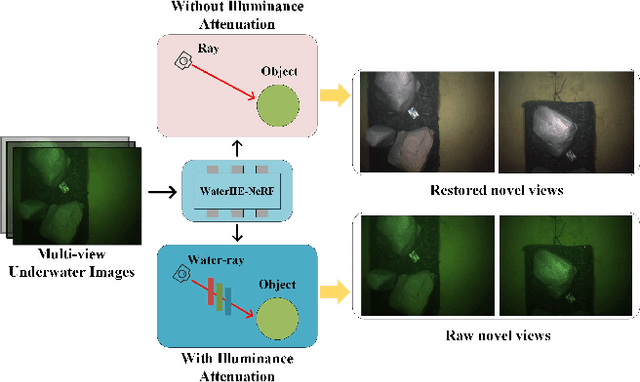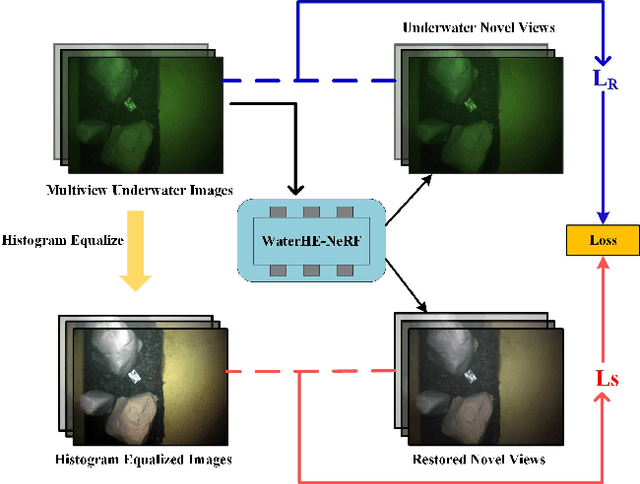Zongxin He
WaterHE-NeRF: Water-ray Tracing Neural Radiance Fields for Underwater Scene Reconstruction
Dec 12, 2023



Abstract:Neural Radiance Field (NeRF) technology demonstrates immense potential in novel viewpoint synthesis tasks, due to its physics-based volumetric rendering process, which is particularly promising in underwater scenes. Addressing the limitations of existing underwater NeRF methods in handling light attenuation caused by the water medium and the lack of real Ground Truth (GT) supervision, this study proposes WaterHE-NeRF. We develop a new water-ray tracing field by Retinex theory that precisely encodes color, density, and illuminance attenuation in three-dimensional space. WaterHE-NeRF, through its illuminance attenuation mechanism, generates both degraded and clear multi-view images and optimizes image restoration by combining reconstruction loss with Wasserstein distance. Additionally, the use of histogram equalization (HE) as pseudo-GT enhances the network's accuracy in preserving original details and color distribution. Extensive experiments on real underwater datasets and synthetic datasets validate the effectiveness of WaterHE-NeRF. Our code will be made publicly available.
DGNet: Dynamic Gradient-guided Network with Noise Suppression for Underwater Image Enhancement
Dec 12, 2023Abstract:Underwater image enhancement (UIE) is a challenging task due to the complex degradation caused by underwater environments. To solve this issue, previous methods often idealize the degradation process, and neglect the impact of medium noise and object motion on the distribution of image features, limiting the generalization and adaptability of the model. Previous methods use the reference gradient that is constructed from original images and synthetic ground-truth images. This may cause the network performance to be influenced by some low-quality training data. Our approach utilizes predicted images to dynamically update pseudo-labels, adding a dynamic gradient to optimize the network's gradient space. This process improves image quality and avoids local optima. Moreover, we propose a Feature Restoration and Reconstruction module (FRR) based on a Channel Combination Inference (CCI) strategy and a Frequency Domain Smoothing module (FRS). These modules decouple other degradation features while reducing the impact of various types of noise on network performance. Experiments on multiple public datasets demonstrate the superiority of our method over existing state-of-the-art approaches, especially in achieving performance milestones: PSNR of 25.6dB and SSIM of 0.93 on the UIEB dataset. Its efficiency in terms of parameter size and inference time further attests to its broad practicality. The code will be made publicly available.
AMSP-UOD: When Vortex Convolution and Stochastic Perturbation Meet Underwater Object Detection
Aug 23, 2023



Abstract:In this paper, we present a novel Amplitude-Modulated Stochastic Perturbation and Vortex Convolutional Network, AMSP-UOD, designed for underwater object detection. AMSP-UOD specifically addresses the impact of non-ideal imaging factors on detection accuracy in complex underwater environments. To mitigate the influence of noise on object detection performance, we propose AMSP Vortex Convolution (AMSP-VConv) to disrupt the noise distribution, enhance feature extraction capabilities, effectively reduce parameters, and improve network robustness. We design the Feature Association Decoupling Cross Stage Partial (FAD-CSP) module, which strengthens the association of long and short-range features, improving the network performance in complex underwater environments. Additionally, our sophisticated post-processing method, based on non-maximum suppression with aspect-ratio similarity thresholds, optimizes detection in dense scenes, such as waterweed and schools of fish, improving object detection accuracy. Extensive experiments on the URPC and RUOD datasets demonstrate that our method outperforms existing state-of-the-art methods in terms of accuracy and noise immunity. AMSP-UOD proposes an innovative solution with the potential for real-world applications. Code will be made publicly available.
 Add to Chrome
Add to Chrome Add to Firefox
Add to Firefox Add to Edge
Add to Edge